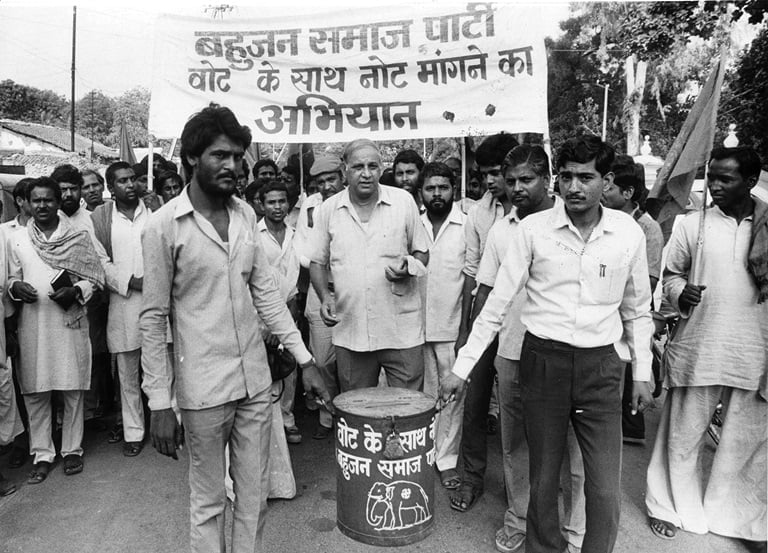“If you call someone as Chamcha, he will not like it and is likely to go against you. However, when you are calling the age the Chamcha Age, you are biting so many, and they may hit back. But as Chamcha cannot operate on its own, the operator may hit you back with Chamcha. We should, therefore, be prepared for the ‘Chamcha Attack’…At any rate, the Chamcha attack should not frighten us because a Chamcha is not a powerful or deadly weapon. Besides, we must aim at the hand that uses the Chamcha. If hit hard, the Chamcha will fall,” wrote Manyavar Kanshi Ram in his revolutionary book, The Chamcha Age (An Era of the Stooges).
‘Chamcha‘ here is a deprecatory connotation referring to any individual who compromises the community’s interests for self-motivated reasons.
‘Chamcha‘ here is a deprecatory connotation referring to any individual who compromises the community’s interests for self-motivated reasons. Saheb Kanshi Ram wrote this book “to distinguish between the genuine and the counterfeit leadership“, to elucidate how the oppressed Bahujan community has been ignored, controlled, and tormented by those who lack a social conscience and self-respect, as he explained. In the contemporary scenario, where people are quick to become sycophants of the ruling classes worldwide, Kanshi Ram’s writing becomes more relevant with each day. In this book, he stated how Dr B R Ambedkar’s leadership aimed to get Bahujans both ‘recognition and rights‘ and how he had been forced to sign the Poona Pact.
Also read: Mayawati: An Icon Of Bahujan Struggle

Born to a Ramdasia Sikh family of the Chamar caste on 15 March 1934 in Ropar district, Punjab, British India, Manyavar Kanshi Ram Saheb had outrightly changed the political discourse and social ideology in India, not only on a mass level but also on an individual level. In a country where people join politics to evade crimes that they have committed or for personal capital accumulation, Kanshi Ram chose politics for the community. He served and led by example, travelling the country’s length and breadth on a bicycle, for no personal benefits but only for the Bahujan community’s cause.
A true leader of the marginalised, he taught generations to hold the pencil right, calculate the society upright, create slogans that will not dilute the marginalised oppression but will assert it from the roots vehemently.
A true leader of the marginalised, he taught generations to hold the pencil right, calculate the society upright, create slogans that will not dilute the marginalised oppression but will assert it from the roots vehemently. He believed not only in thinking ideologically correctly but also in winning the ground pragmatically.
Kanshi Ram had graduated with a BSc degree from Government College, Ropar, in 1956. He worked at several central government organisations, including the Geological Survey of India. In the book ‘Behenji: A Political Biography of Mayawati‘, Ajoy Bose writes that when Kanshi Ram joined the Defence Research and Laboratory Organisation, he was aghast at the heinous casteist discrimination meted out to the Scheduled Castes like Mahars and Matangs. As he read more of Babasaheb Dr B R Ambedkar’s and Mahatma Jyotirao Phule’s writings, his anguish at the oppressed’s agony heightened. He participated in Scheduled Caste employees’ agitations as they asked for leaves on Dr Ambedkar and Buddha’s birth anniversaries.
Also read: Student Politics And Ambedkar: Voicing Dalit Bahujan Agency In University Spaces
Consequently, he was put in trouble by upper caste officers. He also took a stand for a young Dalit woman whom a upper caste officer had refused appointment despite her having all qualifications. Kanshi Ram left his government job to fight for the more significant cause. He brought the Bahujan community together, who had been exploited by the oppressor castes. He brought together the Scheduled Castes, the Other Backward Classes, the Scheduled Tribes, and the minorities through his inclusive additive strategy and identity-assertion.
Manyavar Kanshi Ram had no inherited wealth, contacts or surnames, he built from scratch a strong and electrifying Bahujan movement in the country. He amalgamated art, social science and mass mobilisation to drive a change. Kanshi Ram brought together anti-caste art from the grassroots.
He introduced Periyar to villages in the north, eastern, central and western India; he brought out the legacies of Birsa Munda, Savitribai Phule, Nangeli, Iyothee Thass, Nandanar and Jhalkaribai. He understood what people would comprehend and talked to them in a language that connected them together. Kanshi Ram did not speak to manifest how different he was to people; instead, he communicated how similar he was to them. He was a part of the people; the people were a part of him. He fought for social agitation, political power and economic emancipation. Through his comprehensive strategy, he broke the political hegemony of the oppressor castes.
Manyawar Kanshi Ram termed the so-called mainstream media as ‘Manuwadi’. Consequently, he commenced publishing his own magazines and newspapers under his brilliant editorial proficiency. He brought out Bahujan Times, The Untouchable India, The Oppressed Indian, Bahujan Nayak, Shramik Sahitya, Economic Upsurge, B R C Bulletin, Bahujan Sahitya, Bahujan Sangathak, and Arthik Utthan, which played an instrumental role in awakening and bringing together the Bahujan consciousness, which the mainstream media had hitherto kept unaware of their own oppression with no coverage of caste crimes, and brazen cover-up of the caste angles in reportage of caste atrocities, student suicides, and further, caste favouritism among the upper castes.
Also read: In Defense Of Identity Politics: The Need For Bahujan Representation
Unlike patriarchal upper castes, Kanshi Ram chose Mayawati as his protégé, and when he passed away, his last rites were performed by her as per Buddhist tradition.
From the gatekept fences of the parliament, Kanshi Ram brought politics to the streets and the fields. He knew that society could thrive only when the resources are equally distributed. He articulated slogans that the masses could easily comprehend. He vociferously instructed Bahujans to stop accepting the oppression and the internalised inferiority. He enunciated to Bahujans the worth of their vote, vehemently asserting that the parliament should be full of those who speak for the eighty-five per cent of the marginalised population. His slogans, his life, reverberate and inspire till today and would forever, for he asserted, “Jiski jitni sankhya bhari, uski utni hissedari” (Share of the community should be in proportion with its population).
Featured Image Source: Bahujan Samaj Education
About the author(s)
Ankita Apurva was born with a pen and a sickle.





